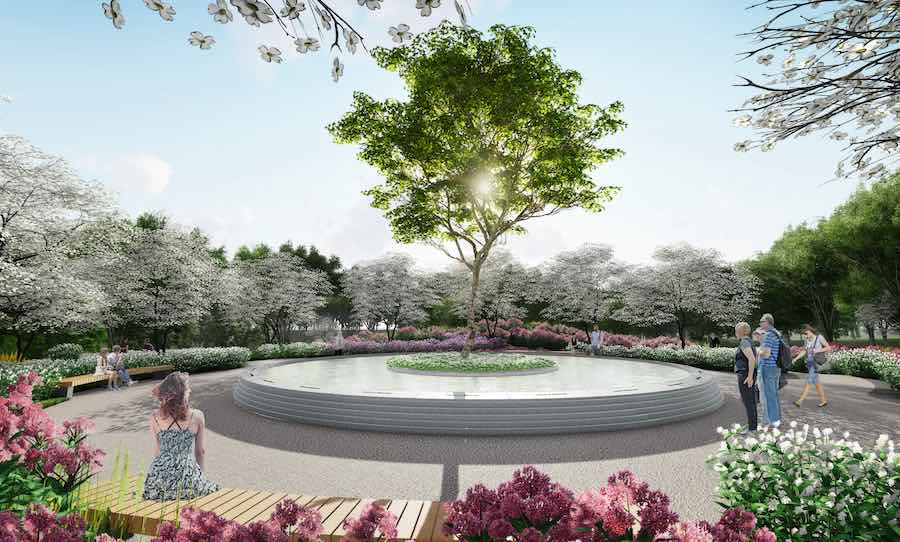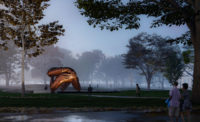Daniel Affleck and Ben Waldo, two young designers at SWA Group in San Francisco, had talked about entering an architectural competition on their own.
When the pair spotted calls for submissions in 2017 for a memorial to victims of the Sandy Hook school shooting in Connecticut five years before, they were moved by the unspeakable tragedy and intrigued by the challenge.
The two met for coffee and spent hours talking over concepts before putting pen to paper and sketching out their proposal and sending it off to the Sandy Hook Memorial Commission.
A half decade after they entered the competition, “The Clearing,” the $3.7-million memorial created by the two designers and their firm, SWA, opened quietly to the public earlier this month—just ahead of the shooting’s 10th anniversary on Dec. 14.
The memorial’s debut was the culmination of five years of intensive planning, design and ultimately construction that required scrupulous attention to detail and a focus on precision.
“It’s more typical to dive in and start drawing,” Waldo said. “The weight behind the subject matter was so much greater that we did pause a bit before we started drawing.”

The names of 20 children and six educators who died at Sandy Hook are inscribed on the granite capstones of the inner part of the circle holding the water.
Photo by David Lloyd, courtesy SWA
A landscape transformed
At the heart of the memorial is a large granite circle with a water feature in the center. The names of 20 children and six educators who died at Sandy Hook are inscribed on the granite capstones of the inner part of the circle holding the water.
In the center of the water feature, in turn, is a mini island with a single young sycamore tree, which is expected to grow and expand its canopy in the years ahead.
During special occasions, the flow of water can be shifted so that special offerings, like a candle or a bouquet of flowers on a float, will slowly spiral toward the center and circle the sycamore tree.

The memorial and the carefully laid out trails that circle around it are located a quarter mile away from where the new Sandy Hook Elementary School now stands, representing a complete transformation from what was on there before.
Photo by Neil Landino, courtesy SWA
Meanwhile, the designers surrounded the granite circle and its water with a carefully sculpted landscape. A “circling network of paths” winds its way “through a woodland” and “across ponds and meadows,” SWA notes in a press release on the memorial’s opening.
The memorial and the carefully laid out trails that circle around it—a quarter mile away from where the new Sandy Hook Elementary School now stands in Newtown, Conn.—represent a complete transformation from what was on there before.
Affleck, who grew up in Connecticut, got his first look at the site after his father took some photos of the area for him.
The photos revealed a neglected, overgrown area, including an abandoned ballfield with knee high grass and a pair of ponds.
At the same time, Affleck and Waldo were studying other similar memorials as well, including the 9/11 Memorial Museum in New York, the Vietnam Veterans Memorial in Washington, D.C., and the Holocaust Memorial in Berlin.
“What we liked about all the memorials was that there was an interactive quality,” Affleck said.
The final design drew its inspiration from both other modern monuments to terrible tragedies, such as the 9/11 Memorial, as well as the meditative qualities of the New England landscape.
Stone pathways are meant to be evocative of Connecticut and New England, while the design also takes advantage of the mature maples that were already on the site and which provide a “sense of envelopment and enclosure in nature,” notes SWA’s description of the memorial.
“We liked this idea of a walking meditation,” Affleck said. “We had a good feeling about this one,” Affleck said of the design he and Waldo presented. “Sometimes you just come up with the right solution organically.”
When their proposal had made it into the top 10 and winning looked like a real possibility, Affleck and Waldo engaged their firm, SWA, to help with the project.
The Sandy Hook Permanent Memorial Commission wound up choosing “The Clearing” out of 189 submissions from around the world.

A mini island with a single young sycamore tree sits in the center of the water feature. The tree is expected to grow and expand its canopy in the years ahead.
Photo by David Lloyd, courtesy SWA
After coming out on top, the two designers and their firm assembled a team to work on the project, a mix of local firms and talent from afar: Artemis Landscape Architects out of Sandy Hook, JMC Civil Engineering, based in Armonk, N.Y., Atelier 10’s New Haven, Conn. office designed the lighting, and Fluidity out of Los Angeles to build the water feature, among others.
Downes Construction Co., the New Britain-based general contractor, faced a number of challenges during the roughly year-long building process, including a complete lack of infrastructure. Electrical, water and drainage systems all had to be brought to the site and tied into the local grid.
An extremely high and exacting level of precision was also required, said Jason Smith, project superintendent for Downes.
The granite circle encompassing the water feature was made up of 17 different concentric circles extending out the outer edge of the benches.
Everything was built from a literal center point where the tree stands in the middle, with “less than three-eighths of an inch of tolerance for the entire circumference of each one of those radiuses,” Smith noted.
All the different contractors had to work off a single center point on each radius.
“If we were off with the tolerances at all, it would defeat the intention of this memorial,” Smith said. “The 17 different radiuses and circumferences had to be met in order to fit this granite built in a factory in Canada.”
The project also required extensive coordination with various elected and municipal officials in Newton, which was a “refreshing” break from the big city bureaucracies they typically deal with, noted Affleck, who grew up in small-town Connecticut himself.
“If we needed to talk with the first selectman or the director of public works, we would just call them up and they would answer the phone,” Affleck said. “It was refreshing.”
But while working with the local officials and choosing the right contractors were key, empathy also proved to be a crucial ingredient in the design process.
“We had to take a step back … and remove ourselves and our gut instincts and put ourselves in the shoes of the people for whom the space is for,” Waldo said.






Post a comment to this article
Report Abusive Comment